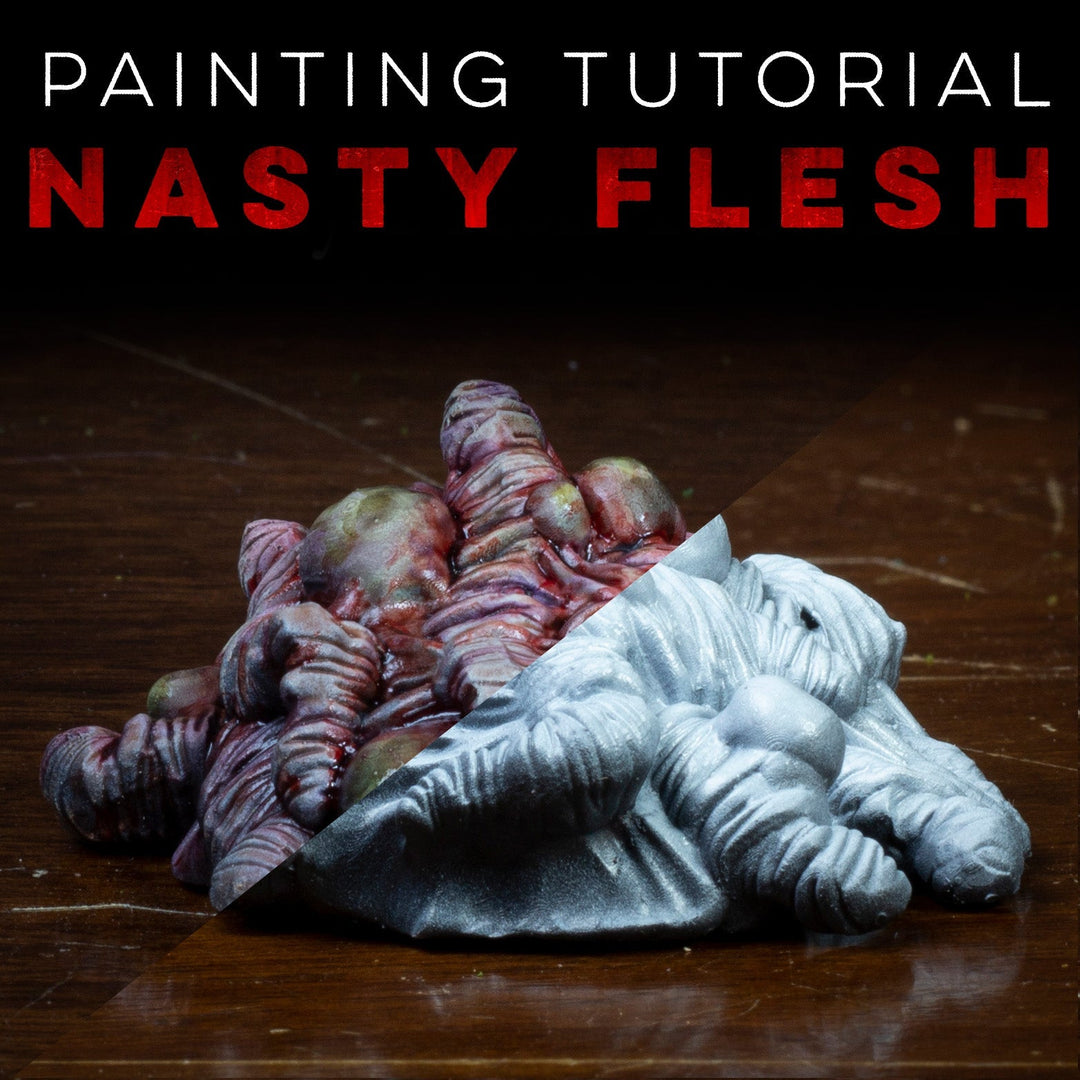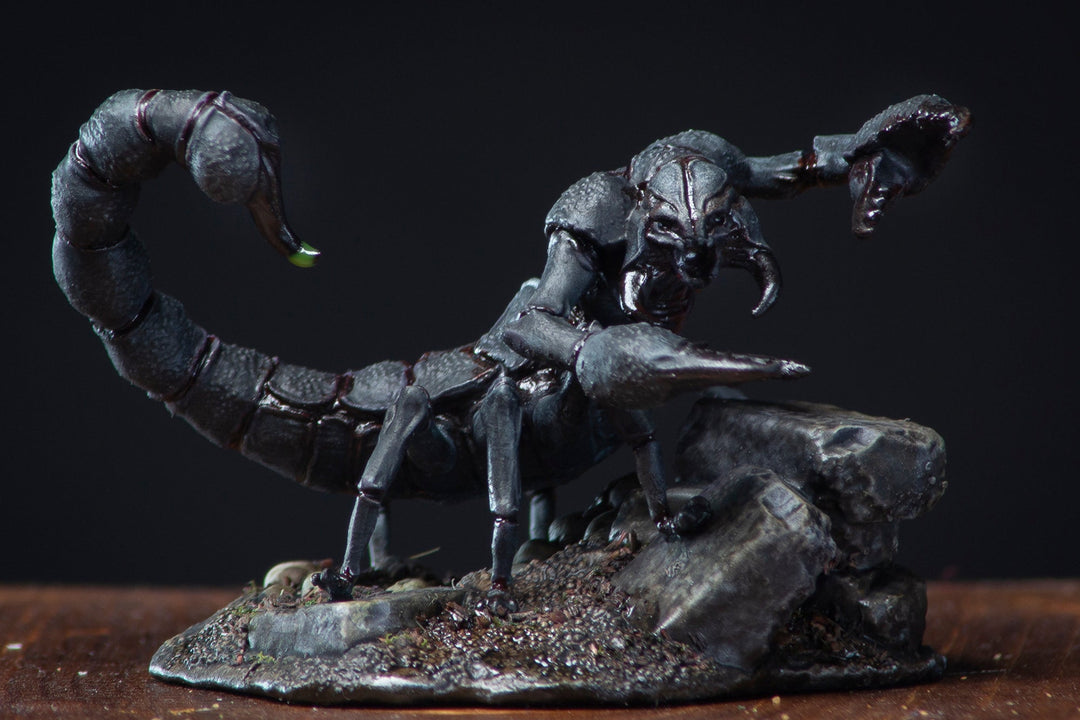How to Paint Black (Scorpion Edition)
Painting black isn't as hard as you think. We know what you’re thinking, “How can I make black not look like I've just chucked a load of black paint at it?”, “How on earth do you shade black?!?”, “Can I give black a visible texture?”... The answer is yes, yes you can. Learning to paint interesting black is a GREAT skill to master, and with this 10 step example, Marcus from Bestiarum Games, will show you how to do it, let's dive in -

Back in August 2021 Bestiarum released the Desert of Giant Skulls collection and I wanted to put together a bit of a step-by-step for how I’m tackling the Keltrian Worker. I was certain from the moment I saw them that I wanted to do a strong glossy black chitin scheme, similar to an Emperor Scorpion.

Source: Google Images - Charming fellow I’m sure.
Looking at this reference, the prevailing colour is of course the deep, glossy black but, what’s interesting me most is those brown/purple hues you can see in its limbs.
Before we get into it, here’s a quick list of the paints I’m using:
- Black Templar Contrast – Citadel
- Wyldwood Contrast – Citadel
- Skeleton Horde Contrast – Citadel
- Dawnstone Dry – Citadel
- Flayed One Flesh - Citadel
- Vallejo Model Wash - Black 76.518 – Vallejo
- Druchii Violet – Citadel
- Agrax Earthshade – Citadel
- Athonian Camoshade – Citadel
- Blood for the Blood God - Citadel
- Nurgle’s Rot - Citadel
In addition, I’m using Vallejo black primer, Model Air White and Gloss and Matte Varnishes. As usual - no need to follow these brand suggestions directly, others are available!
Step One: Zenithal Basecoat

Sweet sweet monochrome.
Per usual I’m starting with a zenithal basecoat to lay out my shadows and give the contrast paint something to interact with.
Step Two: Contrast

Love how quick you can get things looking decent with just a bit of glazing.
From here, I’m going to quickly slap down some base colour with contrast. In this instance – Black Templar on the carapace, Wyldwood for the dirt, Skeleton Horde on the skulls and Basilicanum Grey for the stones.
The release itself is more of a desert theme, but I opted for a dirt base to match the rest of my collection. If you’re following along and wanted a desert look, try subbing out the Wyldwood for Aggaros Dunes or some other yellow-brown. Otherwise steps should be the same.
Step Three: Drybrush

Dusty!
Once the contrast dries, I hit the model with some drybrushing. I’m starting with a light grey on the Keliterian and the stones, then an ivory on the base. I’m also applying a very small amount of ivory to draw out the key features of the sculpt – head, claw tips and stinger.
Step Four: Shade work

That’s better.
I’m now going to slap down some initial shade over the model. I’m starting here with an overall layer of Vallejo Black Wash on the Keltrian, taking care not to let it pool.
Mini review – I’ve only just swapped to Vallejo black wash and it’s great decent so far, it’s a little more flow-y than Nuln oil and dries lighter than it applies, but for a better paint-pot and price point I’m happy to make the swap.

Contrast/Drybrush/Agrax is a great way of getting a nice, quick base texture.
Next, some Agrax Earthshade on the base, I’m also applying this to the stones, note how this tonal change helps separate the black scorpion from the grey rocks.

Difficult to spot I know, look at the cheeks and around the stinger.
From here, I used some Druchii Violet (purple) shade on the fleshier parts of the Keliterian and between the carapace plates, using the reference image from earlier as my guide.
Step Five: Building up the Black

Darker and Darkerer
Here, I’m going to build up the black on the carapace, I’m going to do this initially with Black Templar contrast paint.
I’m adding a few more thin layers of Black Templar to the areas I’d expect the chitin to be smoothest and hardest, I’ll be hitting these with gloss effects later. I’m aiming to get pretty close to pure black.
Next, we’re going to apply some more Black Templar contrast to edges where two parts meet, for instance, I’ve increased the darkness on his shoulder, where it meets the head to help draw attention to head itself. As we’re working with black on black, the main tool in our arsenal for definition is tonal variation.

Darkerer and Darkererer
Next, we’re adding another layer of black wash/shade to the model. Instead of an all-over coat, we’re focusing our efforts on areas of texture and shadow, this is serving to further increase that subtle tonal variation between the chitin plates.
Step Six: Green

Mossy stones is best stones.
To finish off the shade work, I add a bit of green shade to the base with Athonian Camoshade. As green won’t be present on the Keliterian, this will serve to further bring the sculpt out from the base and draw the eye.
Per usual, I’m applying the green in patches to flat surfaces, using the shade more as a tint than to darken the crevices.
Step Seven: Basing Elements

Not sure what this stuff is to be honest… I think it’s just pencil shavings.
To cap everything off, I’m adding a little flock to the base. This is great to help settle the piece and add a new, natural texture to offset the sometimes-digital look of a 3D print.
Outside of desert species, Scorpions tend to live in damp locales with plenty of leaf litter, so I’m using a brown flock-ish material.
It’s fixed with some PVA, allowed to dry then coated with another thin layer of PVA to fix it in place.

I’m happier when things are duller.
Once dry, I’ve given the flock a quick Drybrush with light brown, then washed with a bit of Agrax Earthshade.
Step Seven: Varnish

Just like that, all our previous hard work is muted into a matte nothingness.
Next up, I’m giving the whole piece a varnish with gloss (for protection) then matte varnish through my airbrush, this will standardise the paint finishes and augment the next step – more Shades and Washes!
Step Eight: More Shadwork

More?!
We’re going to back in for some more shade and wash work now, focusing on crevices and shadowed areas of the mini that need more definition, so no all-over washes. I’m concentrating my efforts on the Vallejo Black wash and Agrax Earthshade, but you might want to work in a little more purple, or your chosen accent colour too.

The purple effect is much more visible here.
Step Nine: Gloss Effects


I’m finishing everything up with a bit of gloss effect paint, starting with my old staple, blood for the blood god, I’m running the paint along the seams where chitin plates join and softer bits are exposed.

Finally, a little more gloss effects, this time clear varnish, thickly applied in patches on the base to create puddles, then a drop of Nurgle’s Rot on the tip of the beast’s stinger for a little drop of poison.
Step Ten: Finished!
At this point, I’m calling the model done. Overall I’m pretty happy with the results, painting all-black schemes is loads of fun.
Hope my step by step helps a bit with figuring out your own techniques, as far as key points I'd like to impart:
- The impact vivid colours can have on an otherwise drab scheme, particularly the purple over black was a lot more impactful than I expected.
- A paint scheme doesn’t have to have too many colours to get good results.
Thanks for checking this out, happy hobbying gang!
Cheers,
Marcus




Leave a comment